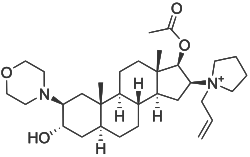 Molecular structure of rocuronium | |
 3D representation of a rocuronium molecule | |
| Clinical data | |
|---|---|
| Trade names | Esmeron, Zemuron |
| Other names | [3-hydroxy-10,13-dimethyl-2-morpholin-4-yl-16-(1-prop-2-enyl-2,3,4,5-tetrahydropyrrol-1-yl)-2,3,4,5,6,7,8,9,11,12,14,15,16,17-tetradecahydro-1H-cyclopenta[a]phenanthren-17-yl] acetate |
| AHFS/Drugs.com | Monograph |
| Routes of administration | Intravenous |
| ATC code | |
| Legal status | |
| Legal status | |
| Pharmacokinetic data | |
| Bioavailability | NA |
| Protein binding | ~30% |
| Metabolism | some de-acetylation |
| Elimination half-life | 66–80 minutes |
| Excretion | Unchanged, in bile and urine |
| Identifiers | |
| |
| CAS Number | |
| PubChem CID | |
| IUPHAR/BPS | |
| DrugBank | |
| ChemSpider | |
| UNII | |
| KEGG | |
| ChEMBL | |
| CompTox Dashboard (EPA) | |
| ECHA InfoCard | 100.122.235 |
| Chemical and physical data | |
| Formula | C32H53BrN2O4 |
| Molar mass | 609.690 g·mol−1 |
| 3D model (JSmol) | |
| |
| |
| | |
Rocuronium bromide (brand names Zemuron, Esmeron), also referred to as "roc", [2] is an aminosteroid non-depolarizing neuromuscular blocker or muscle relaxant used in modern anaesthesia to facilitate tracheal intubation by providing skeletal muscle relaxation for surgery or mechanical ventilation. It is used for standard endotracheal intubation, as well as for rapid sequence induction. It can also be used with other drugs for medical assistance in dying. [3]